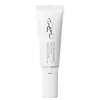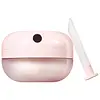What's inside
What's inside
 Key Ingredients
Key Ingredients

 Benefits
Benefits

 Concerns
Concerns

 Ingredients Side-by-side
Ingredients Side-by-side

Bis-Diglyceryl Polyacyladipate-2
EmollientDiisostearyl Malate
EmollientHydrogenated Polyisobutene
EmollientPentaerythrityl Tetraisostearate
EmollientOctyldodecanol
EmollientMicrocrystalline Wax
Emulsion StabilisingHydrogenated Olive Oil
Skin ConditioningHelianthus Annuus Seed Oil
EmollientSilica Silylate
EmollientOlea Europaea Fruit Oil
MaskingTriolein
Skin ConditioningBoron Nitride
AbsorbentHydrogenated Soybean Oil
EmollientPolyethylene
AbrasiveSynthetic Wax
AbrasiveOlea Europaea Oil Unsaponifiables
Skin ConditioningTocopheryl Acetate
AntioxidantCeramide NP
Skin ConditioningGlyceryl Dioleate
EmollientStearic Acid
CleansingPentaerythrityl Tetra-Di-T-Butyl Hydroxyhydrocinnamate
AntioxidantLupinus Albus Seed Extract
Skin ConditioningTocopherol
AntioxidantGlycine Soja Oil
EmollientBHT
AntioxidantBis-Diglyceryl Polyacyladipate-2, Diisostearyl Malate, Hydrogenated Polyisobutene, Pentaerythrityl Tetraisostearate, Octyldodecanol, Microcrystalline Wax, Hydrogenated Olive Oil, Helianthus Annuus Seed Oil, Silica Silylate, Olea Europaea Fruit Oil, Triolein, Boron Nitride, Hydrogenated Soybean Oil, Polyethylene, Synthetic Wax, Olea Europaea Oil Unsaponifiables, Tocopheryl Acetate, Ceramide NP, Glyceryl Dioleate, Stearic Acid, Pentaerythrityl Tetra-Di-T-Butyl Hydroxyhydrocinnamate, Lupinus Albus Seed Extract, Tocopherol, Glycine Soja Oil, BHT
Diisostearyl Malate
EmollientHydrogenated Polyisobutene
EmollientPhytosteryl/Isostearyl/Cetyl/Stearyl/Behenyl Dimer Dilinoleate
Skin ConditioningPolybutene
Hydrogenated Poly(C6-14 Olefin)
EmollientButyrospermum Parkii Butter
Skin ConditioningMicrocrystalline Wax
Emulsion StabilisingSynthetic Wax
AbrasiveEthylene/Propylene/Styrene Copolymer
Sucrose Tetrastearate Triacetate
EmollientMica
Cosmetic ColorantCI 77891
Cosmetic ColorantEuphorbia Cerifera Wax
Ethylhexyl Palmitate
EmollientParfum
MaskingCandelilla Wax Esters
Astrocaryum Murumuru Seed Butter
EmollientTribehenin
EmollientMenthoxypropanediol
MaskingGlycerin
HumectantCocos Nucifera Oil
MaskingOenothera Biennis Oil
EmollientLecithin
EmollientButylene/Ethylene/Styrene Copolymer
Sorbitan Isostearate
EmulsifyingCopernicia Cerifera Wax
Dehydroacetic Acid
PreservativeAdenosine
Skin ConditioningTocopherol
AntioxidantLactic Acid
BufferingPentaerythrityl Tetra-Di-T-Butyl Hydroxyhydrocinnamate
AntioxidantPalmitoyl Tripeptide-1
Skin ConditioningDiisostearyl Malate, Hydrogenated Polyisobutene, Phytosteryl/Isostearyl/Cetyl/Stearyl/Behenyl Dimer Dilinoleate, Polybutene, Hydrogenated Poly(C6-14 Olefin), Butyrospermum Parkii Butter, Microcrystalline Wax, Synthetic Wax, Ethylene/Propylene/Styrene Copolymer, Sucrose Tetrastearate Triacetate, Mica, CI 77891, Euphorbia Cerifera Wax, Ethylhexyl Palmitate, Parfum, Candelilla Wax Esters, Astrocaryum Murumuru Seed Butter, Tribehenin, Menthoxypropanediol, Glycerin, Cocos Nucifera Oil, Oenothera Biennis Oil, Lecithin, Butylene/Ethylene/Styrene Copolymer, Sorbitan Isostearate, Copernicia Cerifera Wax, Dehydroacetic Acid, Adenosine, Tocopherol, Lactic Acid, Pentaerythrityl Tetra-Di-T-Butyl Hydroxyhydrocinnamate, Palmitoyl Tripeptide-1
 Reviews
Reviews

Ingredients Explained
These ingredients are found in both products.
Ingredients higher up in an ingredient list are typically present in a larger amount.
Diisostearyl Malate is an emollient and most often used in lip products. It comes from isostearyl alcohol, a fatty acid, and malic acid, an AHA.
As an emollient, Diisostearyl Malate helps create a thin film on your skin to trap moisture in. This helps keep your skin soft and smooth.
Hydrogenated Polyisobutene is a synthetic polymer. Polymers are compounds with high molecular weight. Hydrogenated Polyisobutene is an emollient and texture enhancer.
In one study, Hydrogenated Polyisobutene showed better skin hydration levels than Caprylic/Capric Triglyceride. As an emollient, it helps keep your skin soft and hydrated by trapping moisture in.
Hydrogenated Polyisobutene is often used as a mineral oil replacement.
Learn more about Hydrogenated PolyisobuteneMicrocrystalline Wax is created by de-oiling petroleum. It is highly refined and purified before being added to cosmetics.
Microcrystalline Wax is used to enhance the texture and create even consistency. It helps stabilize a product by preventing ingredients from separating.
Pentaerythrityl Tetra-Di-T-Butyl Hydroxyhydrocinnamate (long name, huh?) is a synthetic antioxidant.
It is used to help stabilize other antioxidants or prevent the color from changing in a product.
As an antioxidant, it helps fight free-radical molecules. Free-radical molecules are capable of damaging our cells and other genetic material. Thus, antioxidants may reduce the signs of aging.
This ingredient is oil-soluble.
Learn more about Pentaerythrityl Tetra-Di-T-Butyl HydroxyhydrocinnamateSynthetic Wax is created from fossil fuels such as natural gas. It is used to enhance texture, adjust pH, and as an occlusive.
It may also be used as an abrasive ingredient to exfoliate the skin.
Synthetic Wax may not be fungal acne safe.
Learn more about Synthetic WaxTocopherol (also known as Vitamin E) is a common antioxidant used to help protect the skin from free-radicals and strengthen the skin barrier. It's also fat soluble - this means our skin is great at absorbing it.
Vitamin E also helps keep your natural skin lipids healthy. Your lipid skin barrier naturally consists of lipids, ceramides, and fatty acids. Vitamin E offers extra protection for your skin’s lipid barrier, keeping your skin healthy and nourished.
Another benefit is a bit of UV protection. Vitamin E helps reduce the damage caused by UVB rays. (It should not replace your sunscreen). Combining it with Vitamin C can decrease sunburned cells and hyperpigmentation after UV exposure.
You might have noticed Vitamin E + C often paired together. This is because it is great at stabilizing Vitamin C. Using the two together helps increase the effectiveness of both ingredients.
There are often claims that Vitamin E can reduce/prevent scarring, but these claims haven't been confirmed by scientific research.
Learn more about Tocopherol